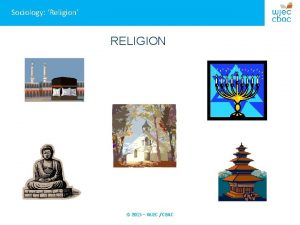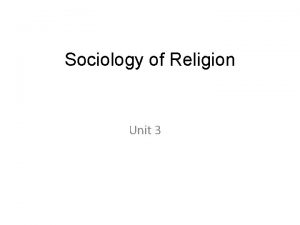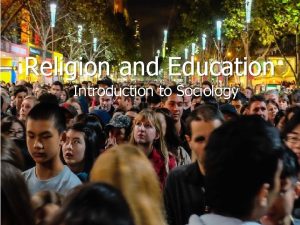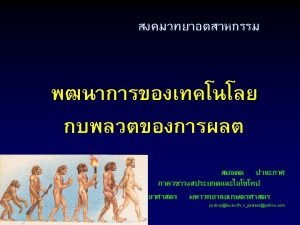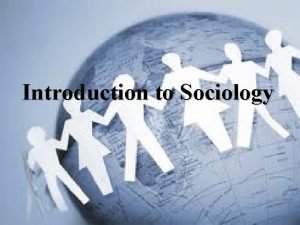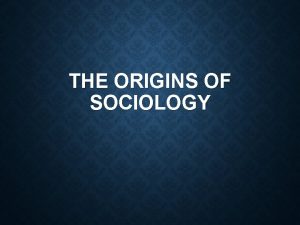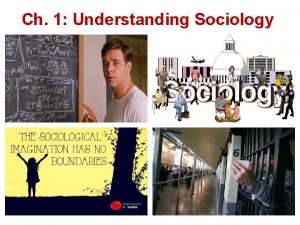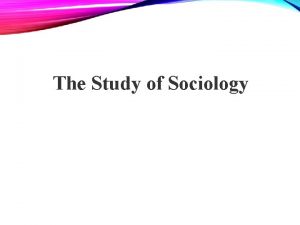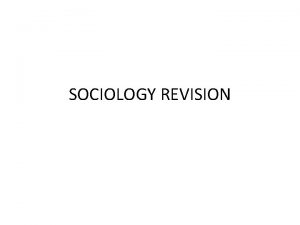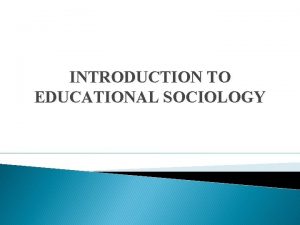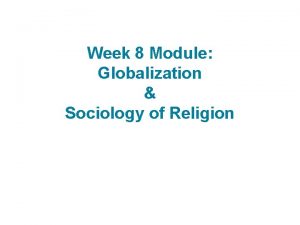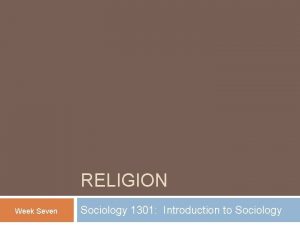The Sociology of Religion A religion is a



















- Slides: 19

The Sociology of Religion • A religion is a system of roles and norms organized around the sacred, which binds people together in groups. • Religions can provide social cohesion, social control, and emotional support. • Religions are characterized by their rituals, symbols, belief systems, and organizational structures.

Religion—A Sociological Definition • Societies have struggled with the need to give meaning to human existence and to provide people with the motivation for survival. • Societies make distinctions between the sacred (anything that is considered to be part of the supernatural world and that inspires awe, respect, and reverence) and the profane (anything considered to be part of the ordinary world and, thus, commonplace and familiar). • This distinction is the basis for of all religions (systems of roles and norms that are organized around the sacred realm and that bind people together in social groups). • Religion is a basic institution, yet it exists in many different forms because different societies give sacred meaning to a wide variety of objects, events, and experiences. • Belief in a particular religion is based on faith rather than on science.

The Functions of Religion Social Cohesion • Strengthens bonds between people • Can lead to conflict between adherents of different religions Social Control • Encourages conformity to norms • Provides a divine purpose for conformity • May inhibit innovation, freedom of thought, and social reform Emotional Support • Helps people endure disappointment and suffering by providing a comfort in believing that harsh circumstances have a special purpose • Attempts to provide answers to the questions concerning life and death


The Nature of Religion Rituals and Symbols Belief Systems • Ritual: An established pattern of behavior through which a group of believers experiences the sacred • Animism: Belief that spirits actively influence human life; two kinds: shamanism and totemism • Often used to mark changes in status such as birth, marriage, and death • Also used to unite believers and reinforce faith • Often includes sacred symbolic objects—such as clothing, herbs, chalices, or books • Theism: Belief in god or gods; two kinds: monotheism and polytheism • Monotheism: The belief in one god, who is usually seen as the creator and moral authority • Polytheism: Belief in a number of gods • Ethicalism: The idea that moral principles have a sacred quality

Organizational Structures • Ecclesia: Structured bureaucratic organization, closely allied with the government, whose officials are highly trained and wield considerable power • Denomination: Well-established religious organization in which a substantial number of the population are members • Sect: Relatively small religious organization that typically has split off from a denomination because of differences concerning beliefs • Cult: New religion whose beliefs differ markedly from those of the society’s major religions

Religion in the United States • Freedom of religion is protected by law and supported by popular opinion. • The general opinion in the U. S. is that all people should hold some religious beliefs. • The United States is home to hundreds of religious denominations, sects, and cults. • Separation of church and state means the U. S. has no national religion. • Immigrants often bring new religions. • Rise of fundamentalist Christianity has become a topic of study. Most Americans belong to one of the major faiths, with the majority being Protestant Christians. Demographic differences among religious groups exist.


Religious Participation Although the majority of Americans claim a religious preference, only about one-third of people attend religious services on a regular basis. Religiosity Secular • Religiosity is the depth of people’s religious feelings • Hard to measure • Depth of feeling does not correlate with participation in services • Secular refers to the nonreligious aspects of society • Decisions based equally on religious teaching and own beliefs

Fundamentalist Christianity • Religious fundamentalism refers to a set of associated beliefs including strict adherence to the religion’s rules and practices and the belief that religion should be the primary force in one’s life. • A variety of fundamentalist Christian groups exist in the United States, but they share the beliefs that: – the Christian Bible is completely and literally true. – Jesus Christ is divine. – their faith will bring personal salvation—the “born-again” experience. – they are obligated to bring Jesus Christ into the lives of all nonbelievers. • 26 percent of Americans describe themselves as “born-again” or evangelical Christians. • These Americans have become politically organized around certain issues such as opposition to abortion and homosexuality.

Cultural Diversity and Sociology Religious Diversity in the United States Since colonial times people have come to the United States to enjoy the freedom to worship how they please. Modern immigrants have helped transform the United States into the most religiously diverse country in the world.

Cultural Diversity and Sociology • Christianity: First Protestants arrived in the 1600 s and the country is today predominantly Christian • Buddhism: Chinese immigrants brought Buddhism during the mid-1800 s and many non-Asian Americans have adopted it • Hinduism: Born in the ancient Indus Valley, today there are more than one million Hindus in the United States • Judaism: Founded about 2000 BC and practiced by 5 million Americans, a number comparable to the Jewish population of Israel • Islam: The religion of Muslims; there are more than 4. 7 million Muslims in the United States • Other Religions: Sikhism, Baha’i, Taoism, Spiritualism, and diverse Native American and New Age faiths; 34 million claim no religion, and more than 1 million are atheists

Similarities Between Sport and Religion Belief Systems • formal beliefs accepted on faith (“Have faith in your team”) • “the will to believe”: believing that an event will occur can actually help make it happen. True Believers • Defenders of social institutions. • New members must be converted through socialization

Similarities Between Sport and Religion Providing Testimony • People who promote their social institutions • “We are Number One!” Patriarchal Dominance • Domination by males, who carry most of the influence. Worship of Saints and Gods • Sports Hall of Fame • Read about heroes and collect memorabilia

Similarities Between Sport and Religion High Councils • Ruling groups that create and maintain rules and codes of conduct Scribes • Reliance on scribes to maintain history and promote awareness regarding ongoing events Psychological Support • Provide support, especially in times of emotional crisis

Similarities Between Sport and Religion Pilgrimages to a Shrine • Attending major sporting events can be seen as having a destination to a promised land. Buildings for Events • Sacred ground to worship as a group. • Physical locations to worship as a group Use of Symbols • Objects, ideas and actions that posses meaning. • The cross in Christianity; a championship ring.

Similarities Between Sport and Religion Written Dramas • Stories that keep followers interested and provide guidelines for proper behavior. Scheduled Events • Keep followers in a routine of ritual • Expected to attend on regular basis. Special Days • Created to stimulate and excite followers. • World Series; Super Bowl

Similarities Between Sport and Religion Collective Emotions • Opportunity to share emotions with the rest of the community. Ritualistic Behavior • Helps the community of followers to have a set of values Competitive Nature • Competition among religions to gain followers.

Similarities Between Sport and Religion Prayer • Hope for divine intervention; unearthly assistance Sense of Identity • Help create self-esteem by creating a sense of belonging and bonding to others.
 What is religion in sociology
What is religion in sociology Western religion vs eastern religion
Western religion vs eastern religion Hệ hô hấp
Hệ hô hấp So nguyen to
So nguyen to Công thức tiính động năng
Công thức tiính động năng đặc điểm cơ thể của người tối cổ
đặc điểm cơ thể của người tối cổ Tỉ lệ cơ thể trẻ em
Tỉ lệ cơ thể trẻ em Các châu lục và đại dương trên thế giới
Các châu lục và đại dương trên thế giới ưu thế lai là gì
ưu thế lai là gì Thẻ vin
Thẻ vin Môn thể thao bắt đầu bằng từ đua
Môn thể thao bắt đầu bằng từ đua Tư thế ngồi viết
Tư thế ngồi viết Cái miệng nó xinh thế
Cái miệng nó xinh thế Hát kết hợp bộ gõ cơ thể
Hát kết hợp bộ gõ cơ thể Từ ngữ thể hiện lòng nhân hậu
Từ ngữ thể hiện lòng nhân hậu Trời xanh đây là của chúng ta thể thơ
Trời xanh đây là của chúng ta thể thơ Tư thế ngồi viết
Tư thế ngồi viết Chó sói
Chó sói V cc cc
V cc cc Thể thơ truyền thống
Thể thơ truyền thống




















